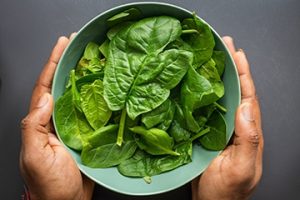 In Massachusetts, some people, particularly women approaching, during or after menopause often ask if consuming spinach could increase their risk of osteoporosis and whether it should be removed from their diet. Others wonder if the amount of spinach should be increased, because of the high calcium content. Even though spinach is high in calcium and would seem beneficial, it also contains oxalates. Oxalates interfere with the absorption of calcium, which could lead to bone decalcification, which is osteoporosis.
In Massachusetts, some people, particularly women approaching, during or after menopause often ask if consuming spinach could increase their risk of osteoporosis and whether it should be removed from their diet. Others wonder if the amount of spinach should be increased, because of the high calcium content. Even though spinach is high in calcium and would seem beneficial, it also contains oxalates. Oxalates interfere with the absorption of calcium, which could lead to bone decalcification, which is osteoporosis.
The problem may depend on how much you eat.
Just like anything, a little may be good, but too much may cause problems. Spinach fits those perimeters perfectly. Normally, the body excretes the oxalate out of the system via urine or the stool. If you eat too much spinach, it can prevent the kidneys from filtering all the oxalate and cause them to bind to the calcium, leading to poor absorption. It’s relatively safe to eat 100 grams of spinach each week, which is about 3 1/3 cups of raw spinach and a little less than a half cup of cooked.
You can remove some of the problems with oxalates by preparing the spinach correctly.
If you love spinach and want to avoid some of the side effects, like kidney stones and an increased risk for osteoporosis, you can do it in two ways. You can use an oxalate reducing enzyme, that breaks down the oxalate in spinach and other food that contains it. It breaks it down and makes it easier to pass. You add it to your drink when you eat spinach or other food high in oxalates. You can remove oxalates via washing and cooking. First wash them thoroughly, then mash them as you run water over them before you cook them, eliminating some of the oxalates. Boil the spinach leaves for five to twelve minutes, in water that you’ve added calcium carbonate, an ingredient in antacids, to bind with the oxalates in spinach. It only takes a little.
Spinach provides other reasons to include it in your diet.
There’s a lot of nutrition in spinach that may negate some of the effects it has on calcium, particularly if you go the extra mile to remove it. It’s a heart healthy veggie that also boosts brain power and can aid in cancer prevention. If you’re eating other high calcium foods, like milk, sardines, yogurt or soy, you’ll still get plenty of calcium in your diet. In fact, spinach won’t pull the calcium out of other food, so if you’re eating a spinach omelet with cheese on top, you’ll still get the calcium for your bones.
- Always talk to your health care professional before adding or eliminating a food from your diet. If you’re concerned about spinach and bone health, just limit it and other high oxalate vegetables.
- Other foods high in oxalates include soy products, almonds, potatoes, beets, navy beans, raspberries and dates. Dates are often used as sweeteners in baked goods, so read labels and watch recipes.
- Substitute foods low in oxalates like kale, bok choy, peanuts, walnuts, pumpkin/sunflower seeds, cashews, broccoli, sweet potatoes, kidney beans, blueberries, blackberries and dried figs.
- Drinking plenty of water, eating foods high in calcium, limiting sugar and sodium and cooking vegetables can help prevent problems created by higher amounts of oxalate in food.
For more information, contact us today at Pro Weight Loss